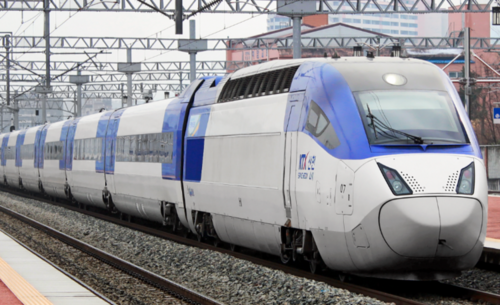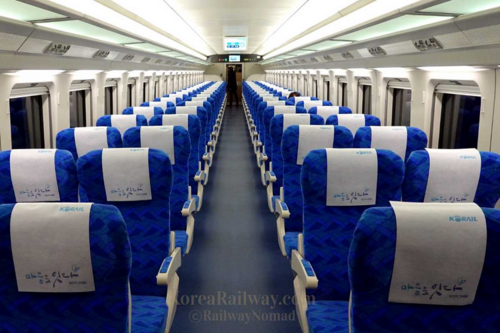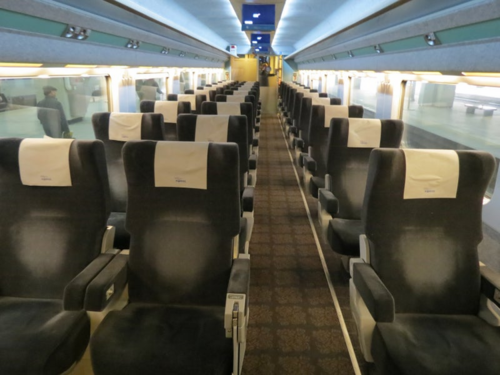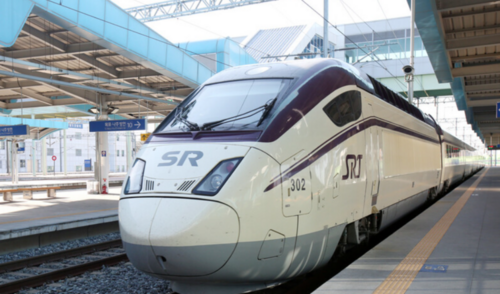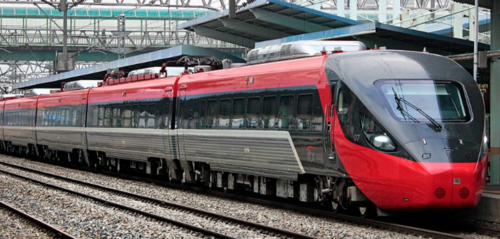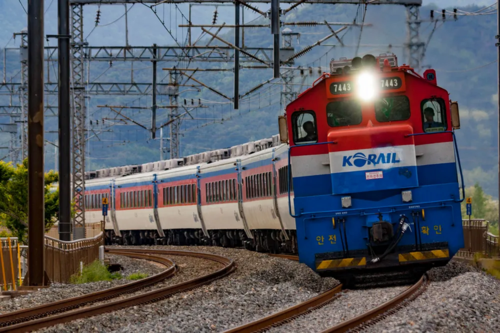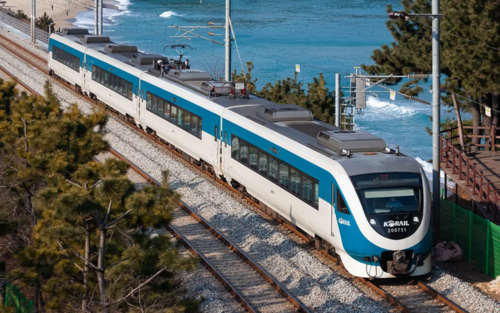(Created page with "== '''Introduction''' == If you are going to tour only in Seoul, it is not difficult to understand public transportation in Korea. Public transportation in Korea is really foreigner-friendly in the capital city. But just one step away from the capital city, the transportation infrastructure is very unfriendly to foreigners. In this article, I will explain about trains in Korea, the fastest way to connect the capital city and all the rest of Korea. Modern high-speed trai...") |
|||
| (3 intermediate revisions by the same user not shown) | |||
| Line 7: | Line 7: | ||
=== Korea Train eXpress(KTX) === | === Korea Train eXpress(KTX) === | ||
[[ | [[File:B1.png|center|500x500px|This is KTX.]] | ||
KTX is a high-speed rail that plays a similar role to Germany's ICE, Japan's Shinkansen, and France's TGV. The top speed is 300 km/h, and all KTX trains start in Seoul. Starting from two locations at Seoul Station and Yongsan Station, the KTX rail links all the rest of Korea. The KTX-Sancheon, a new train, is replacing the old KTX. Here are some important things you need to know about KTX. | KTX is a high-speed rail that plays a similar role to Germany's ICE, Japan's Shinkansen, and France's TGV. The top speed is 300 km/h, and all KTX trains start in Seoul. Starting from two locations at Seoul Station and Yongsan Station, the KTX rail links all the rest of Korea. The KTX-Sancheon, a new train, is replacing the old KTX. Here are some important things you need to know about KTX. | ||
*The most remote areas of Korea that can be reached by KTX are Busan, Yeosu, Jinju, Mokpo, Gangneung, and the East Sea. | *The most remote areas of Korea that can be reached by KTX are Busan, Yeosu, Jinju, Mokpo, Gangneung, and the East Sea. | ||
*The KTX has regular class with 2-2 seating arrangements and special class with 1-2 seating arrangements. The fare for the | *The KTX has regular class with 2-2 seating arrangements and special class with 1-2 seating arrangements. The fare for the special class is 30-40 percent more expensive than that for regular class. But the seats are very large and comfortable. You can drink bottled water for free in the special class. | ||
*Free Wi-Fi is available on all KTX trains. 220V outlets are not installed in all seats in regular class, but in special class. | *Free Wi-Fi is available on all KTX trains. 220V outlets are not installed in all seats in regular class, but in special class. | ||
*KTX fares to Busan, Yeosu, Jinju, and Mokpo, which correspond to the longest distance of 2 hours and 30 minutes to 3 hours, range from KRW 50,000 to KRW 60,000. | *KTX fares to Busan, Yeosu, Jinju, and Mokpo, which correspond to the longest distance of 2 hours and 30 minutes to 3 hours, range from KRW 50,000 to KRW 60,000. | ||
* The KTX fare to Gangneung and the East Sea, which is equivalent to a two-hour medium distance, is KRW 28,000 to KRW 29,000. | * The KTX fare to Gangneung and the East Sea, which is equivalent to a two-hour medium distance, is KRW 28,000 to KRW 29,000. | ||
*The dispatch interval is 30 minutes to 1 hour and 30 minutes for major destinations such as Busan and Mokpo, and 1 hour to 2 hours for smaller cities such as Yeosu, Jinju, Gangneung, and Donghae. | *The dispatch interval is 30 minutes to 1 hour and 30 minutes for major destinations such as Busan and Mokpo, and 1 hour to 2 hours for smaller cities such as Yeosu, Jinju, Gangneung, and Donghae. | ||
[[ | [[File:B2.png|center|500x500px|This is KTX regular class.]] | ||
KTX regular class | [[File:B3.png|center|500x500px|This is KTX special class.]] | ||
[[ | |||
KTX special class | Upper picture is KTX regular class, Lower picture is KTX special class. The KTX train takes a little bit to reach its final destination depending on whether there is an intermediate stop or not. For example, the KTX that stops at every stop on the route may take 2 hours and 50 minutes from Seoul to Busan, but the KTX that runs from Seoul to Busan without stopping takes 2 hours and 20 minutes. It doesn't make much of a difference, but if you want to save time, make sure to check the time it takes to make a reservation. | ||
=== Super Rapid Train(SRT)=== | === Super Rapid Train(SRT)=== | ||
[[ | [[File:B5.png|center|500x500px|This is SRT.]] | ||
SRT is a newly created high-speed rail to support the demand that exceeds Korea's transportation system... You don't need to know the same background, only the operating company is different, and it is almost perfectly identical to KTX. There is only one thing you need to understand to distinguish between KTX and SRT. First, the reservation website is different. Second, it departs from Suseo Station in Gangnam-gu, southeast of Seoul, not from Seoul Station or Yongsan Station. Here are some important things you need to know about SRT. | SRT is a newly created high-speed rail to support the demand that exceeds Korea's transportation system... You don't need to know the same background, only the operating company is different, and it is almost perfectly identical to KTX. There is only one thing you need to understand to distinguish between KTX and SRT. First, the reservation website is different. Second, it departs from Suseo Station in Gangnam-gu, southeast of Seoul, not from Seoul Station or Yongsan Station. Here are some important things you need to know about SRT. | ||
| Line 35: | Line 36: | ||
===ITX-Saemaeul(ITX-새마을)=== | ===ITX-Saemaeul(ITX-새마을)=== | ||
[[ | [[File:B6.png|center|500x500px|This is ITX-Saemaeul.]] | ||
The ITX-Saemaul is a new type of train somewhere between a regular railway and a high-speed railway. It has been deployed since 2014 to replace Saemaeul-ho, Korea's main train when there was no KTX until the early 2000s. It also stops in Korea's small and medium-sized cities, far more than KTX, with a top speed of 150 km/h. If you want to visit a secluded countryside in Korea, which is not commonly known to foreigners, this train can be a good option. Here are some important things you need to know about the ITX-Saemaul. | |||
[[File:B7.png|center|500x500px|This is the inside of the ITX-Saemaeul train looks like.]] | |||
*ITX-Saemaul tickets can be booked on Let's Korail, just like KTX. It only operates with one regular room seat rating. | *ITX-Saemaul tickets can be booked on Let's Korail, just like KTX. It only operates with one regular room seat rating. | ||
*The seating arrangement is 2-2 and stops in all stations where KTX and SRT stop, as well as in small and medium-sized cities in the provinces of Korea where they do not stop. | *The seating arrangement is 2-2 and stops in all stations where KTX and SRT stop, as well as in small and medium-sized cities in the provinces of Korea where they do not stop. | ||
*Of course, the speed is slower than KTX. For example, the Seoul-Busan route, which takes an average of 2 hours and 40 minutes, takes 4 hours and 30 minutes by ITX-Saemaul. However, the fare for the route is a bit cheaper, at around KRW 43,000. | *Of course, the speed is slower than KTX. For example, the Seoul-Busan route, which takes an average of 2 hours and 40 minutes, takes 4 hours and 30 minutes by ITX-Saemaul. However, the fare for the route is a bit cheaper, at around KRW 43,000. | ||
*Free Wi-Fi and 220V outlets are also free to use. | *Free Wi-Fi and 220V outlets are also free to use. | ||
===Mugunghwa(무궁화)=== | ===Mugunghwa(무궁화)=== | ||
[[ | [[File:B8.png|center|500x500px|This is Mugunghwa train.]] | ||
Mugunghwa is the lowest train class in Korea. Of course, the fare is the cheapest, too. For example, a Seoul-Busan trip costs less than KRW 30,000. As expected, KTX and SRT share most of the stops with ITX-Saemaul, as well as all the stops, and even stop at stations in remote mountainous areas that ITX-Saemaul cannot reach. However, as it is the oldest train, it is terribly slow, so even Koreans don't ride Mugunghwa very well unless they really have money. | Mugunghwa is the lowest train class in Korea. Of course, the fare is the cheapest, too. For example, a Seoul-Busan trip costs less than KRW 30,000. As expected, KTX and SRT share most of the stops with ITX-Saemaul, as well as all the stops, and even stop at stations in remote mountainous areas that ITX-Saemaul cannot reach. However, as it is the oldest train, it is terribly slow, so even Koreans don't ride Mugunghwa very well unless they really have money. | ||
| Line 54: | Line 52: | ||
===Nuriro=== | ===Nuriro=== | ||
[[ | [[File:B10.png|center|500x500px|This is Nuriro train.]] | ||
Nuriro is a more modernized train that is a modified version of Mugunghwa's carriages. The speed is slow, similar to that of Mugunghwa, and unlike most other trains, it only runs on very few sections. Foreign tourists visiting Korea rarely get on, and it is mostly used to transport residents in certain areas. Next is the route that Nuriro runs. | Nuriro is a more modernized train that is a modified version of Mugunghwa's carriages. The speed is slow, similar to that of Mugunghwa, and unlike most other trains, it only runs on very few sections. Foreign tourists visiting Korea rarely get on, and it is mostly used to transport residents in certain areas. Next is the route that Nuriro runs. | ||
Latest revision as of 05:09, 16 July 2024
Introduction
If you are going to tour only in Seoul, it is not difficult to understand public transportation in Korea. Public transportation in Korea is really foreigner-friendly in the capital city. But just one step away from the capital city, the transportation infrastructure is very unfriendly to foreigners. In this article, I will explain about trains in Korea, the fastest way to connect the capital city and all the rest of Korea.
Modern high-speed trains and old trains coexist in Korea. But old trains are not dirty or dangerous, and each train has its own purpose. Trains are the easiest and fastest way to get to most provinces in Korea.
High speed train
Korea Train eXpress(KTX)
KTX is a high-speed rail that plays a similar role to Germany's ICE, Japan's Shinkansen, and France's TGV. The top speed is 300 km/h, and all KTX trains start in Seoul. Starting from two locations at Seoul Station and Yongsan Station, the KTX rail links all the rest of Korea. The KTX-Sancheon, a new train, is replacing the old KTX. Here are some important things you need to know about KTX.
- The most remote areas of Korea that can be reached by KTX are Busan, Yeosu, Jinju, Mokpo, Gangneung, and the East Sea.
- The KTX has regular class with 2-2 seating arrangements and special class with 1-2 seating arrangements. The fare for the special class is 30-40 percent more expensive than that for regular class. But the seats are very large and comfortable. You can drink bottled water for free in the special class.
- Free Wi-Fi is available on all KTX trains. 220V outlets are not installed in all seats in regular class, but in special class.
- KTX fares to Busan, Yeosu, Jinju, and Mokpo, which correspond to the longest distance of 2 hours and 30 minutes to 3 hours, range from KRW 50,000 to KRW 60,000.
- The KTX fare to Gangneung and the East Sea, which is equivalent to a two-hour medium distance, is KRW 28,000 to KRW 29,000.
- The dispatch interval is 30 minutes to 1 hour and 30 minutes for major destinations such as Busan and Mokpo, and 1 hour to 2 hours for smaller cities such as Yeosu, Jinju, Gangneung, and Donghae.
Upper picture is KTX regular class, Lower picture is KTX special class. The KTX train takes a little bit to reach its final destination depending on whether there is an intermediate stop or not. For example, the KTX that stops at every stop on the route may take 2 hours and 50 minutes from Seoul to Busan, but the KTX that runs from Seoul to Busan without stopping takes 2 hours and 20 minutes. It doesn't make much of a difference, but if you want to save time, make sure to check the time it takes to make a reservation.
Super Rapid Train(SRT)
SRT is a newly created high-speed rail to support the demand that exceeds Korea's transportation system... You don't need to know the same background, only the operating company is different, and it is almost perfectly identical to KTX. There is only one thing you need to understand to distinguish between KTX and SRT. First, the reservation website is different. Second, it departs from Suseo Station in Gangnam-gu, southeast of Seoul, not from Seoul Station or Yongsan Station. Here are some important things you need to know about SRT.
- Most of the destinations that KTX goes to also go to SRT. They share most railways.
- SRT's carriages are newer, cleaner, and more comfortable. The systems of regular and extra rooms are similar to KTX. The same goes for free Wi-Fi and free bottled water.
- KTX and SRT fares are almost the same, and destination times are similar.
- When you prefer taking the SRT instead of the KTX, it is only when you finish your schedule in the southeastern part of Seoul and depart for the provinces. Other than that, taking the KTX from Seoul Station or Yongsan Station is better.
Other train
Korea has such a well-established high-speed train system that most of the destinations you want to visit are easily accessible with a combination of high-speed trains and local public transportation. However, even Koreans may need to use the following trains, one grade below the express trains, to visit a much smaller city or countryside, which is difficult to visit without cars. They generally stop at far more stations than high-speed trains, such as KTX and SRT, although they are slow.
ITX-Saemaeul(ITX-새마을)
The ITX-Saemaul is a new type of train somewhere between a regular railway and a high-speed railway. It has been deployed since 2014 to replace Saemaeul-ho, Korea's main train when there was no KTX until the early 2000s. It also stops in Korea's small and medium-sized cities, far more than KTX, with a top speed of 150 km/h. If you want to visit a secluded countryside in Korea, which is not commonly known to foreigners, this train can be a good option. Here are some important things you need to know about the ITX-Saemaul.
- ITX-Saemaul tickets can be booked on Let's Korail, just like KTX. It only operates with one regular room seat rating.
- The seating arrangement is 2-2 and stops in all stations where KTX and SRT stop, as well as in small and medium-sized cities in the provinces of Korea where they do not stop.
- Of course, the speed is slower than KTX. For example, the Seoul-Busan route, which takes an average of 2 hours and 40 minutes, takes 4 hours and 30 minutes by ITX-Saemaul. However, the fare for the route is a bit cheaper, at around KRW 43,000.
- Free Wi-Fi and 220V outlets are also free to use.
Mugunghwa(무궁화)
Mugunghwa is the lowest train class in Korea. Of course, the fare is the cheapest, too. For example, a Seoul-Busan trip costs less than KRW 30,000. As expected, KTX and SRT share most of the stops with ITX-Saemaul, as well as all the stops, and even stop at stations in remote mountainous areas that ITX-Saemaul cannot reach. However, as it is the oldest train, it is terribly slow, so even Koreans don't ride Mugunghwa very well unless they really have money.
Mugunghwa is not recommended for foreign tourists who have to visit several tourist attractions in a short period of time. Its cleanliness and convenience are relatively lower than other trains, and it is only worth taking the train when the station that only stops at Mugunghwa Lake is the destination.
Nuriro
Nuriro is a more modernized train that is a modified version of Mugunghwa's carriages. The speed is slow, similar to that of Mugunghwa, and unlike most other trains, it only runs on very few sections. Foreign tourists visiting Korea rarely get on, and it is mostly used to transport residents in certain areas. Next is the route that Nuriro runs.
- Gangneung-Donghae
- Daegu-Pohang Port
- Daegu-Ulsan
- Daegu-Busan
Among them, the Gangneung-Donghae line is operated by KTX, while the Daegu-Pohang, Daegu-Ulsan, and Daegu-Busan sections are operated by KTX, SRT, and ITX-Saemaul, so foreign tourists will not be able to take Nurilo except in a few cases where they have no choice. Just keep in mind that there are trains like this, too.
